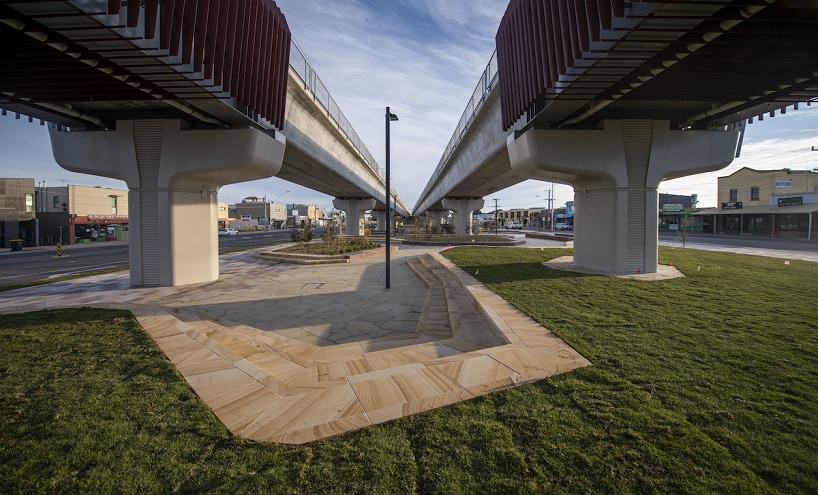You can download the program alliance case study here or find the full text below.
A Program Alliance aims to create mutually beneficial relationships between all involved parties and requires an effective team culture to ensure benefits are optimised.
An agency’s decision to use alliance contracting to deliver a project requires a Strategic Procurement Analysis to be undertaken, and a good understanding of the delivery method that is most likely to best deliver value for money against business case objectives.
It incorporates a legal agreement between all major participants, including the client, which sets out joint risk/ reward arrangements.
The Program Alliance methodology can allow such risks to be worked through collaboratively as the project develops.
Action to benefit good design
- Ensure that the Program Alliance supports a collaborative and multi- disciplinary design environment.
- Ensure that the project team shares the same high expectations of design quality outcomes using Key Result Areas (KRAs) and performance measurement.
- Engage appropriately skilled urban design, architectural and landscape architectural expertise to closely collaborate with the design and construction teams to deliver high quality, integrated design outcomes.
- Ensure the design team/architect are appropriately represented in key design decisions as part of the Alliance Leadership Team and/or the Alliance Management Team.
- Seek early engagement with the OVGA during business case planning and throughout the program lifecycle to embed a rigorous design review process.
- Establish a consistent, expert design review model (Urban Design Advisory Panel or Design Quality Team) that provides independent design review and advice at regular project milestones linked to the performance regime.
- Ensure the program of works are adequately aligned with the State’s ambition for delivering and supporting high quality built form and public realm outcomes.
- Consider incentivising the Program Alliance to ensure that desired design intent, built outcomes and quality are achieved and community benefits are fully realised.
- Ensure an equitable balance of risk/reward for all involved parties.
- Articulate the urban design KRAs early in the process and ensure they are well communicated.
- Provide a realistic contingency that covers both design and construction.
- Ensure the culture of the alliance facilitates a high level of mutual respect and trust between members of the team.
- Ensure that qualitative urban design outcomes are measured across the program to inform future projects.
- Ensure lessons learnt are effectively captured during the planning, design and construction lifecycle and then applied across the program and more broadly across industry.
Case Study: Southern Program Alliance Level Crossing Removal Project
Project Background
The Level Crossing Removal Projects’ (LXRP) Southern Program Alliance (SPA) was formed, following a competitive tender process, to remove level crossings along the Frankston train line. As part of the Alliance’s Initial Works Package (IWP), SPA designed and delivered:
- The removal of three level crossings at Station Street and Eel Race Road, Carrum and Seaford Road, Seaford.
- A well resolved urban design response with a strong coastal corridor identity.
- High quality train station and platform environments exploiting local views and improving the public transport experience
- New recreational and civic spaces below the elevated rail providing better connectivity and improved public realm for the community and public transport users
- Revitalisation of Carrum’s local community and business activity centre through good station precinct planning, introducing high quality facilities and improved access between the station, town centre and foreshore.
- Extensive integrated landscape works along the rail corridor and in the vicinity of Seaford Rd level crossing, including upgrading of RF Miles reserve
- 10km of new linear shared paths along the corridor from Patterson River to Kananook Station.
- Integrated Indigenous cultural motifs into the Karrum Karrum bridge and yarning circle as a welcoming space for Traditional Owners to meet, gather and exchange cultural practices and values.

The Project was delivered as part of a Program Alliance between the State of Victoria (Level Crossing Removal Project) and the SPA. As part of the Alliance, Cox Architecture collaborated with Rush Wright + Associates to deliver on the urban design, station architecture, public realm, landscape and path networks along the corridor.
A Program Alliance was adopted as the most appropriate procurement model given the complexities of the $500+million program of works involving the construction of elevated rail alongside live rail, realignment of a major arterial road close to residents and businesses in a sensitive coastal environment. Following the successful design and delivery of this package of works, the Southern Program Alliance have been engaged to deliver several Additional Works Packages (AWPs) now under construction.
Summary of the key initiatives within the alliance approach that assisted in delivering the design intent:
- A rigorous competitive tender process at the outset involving interactive workshops with proponent teams to develop proposals for the State’s thorough (Project Owner) assessment on a preferred design solution.
- The competitive tender process allowed the State to fully appreciate the scope and complexity of works and better understand the associated risks and costs of these works
- Regular and open engagement and design review with the Urban Design Advisory Panel (UDAP) to ensure a contextually integrated design solution was achieved and design quality was maintained.
- Co-location of the architectural and landscape architectural design teams with the engineering teams led to a close collaboration in a multidisciplinary environment.
- Early collaboration of the urban design team with the engineering and construction team to influence key design decisions including:
-horizontal and vertical geometry of the rail alignment
-the siting, design and integration of the station and corridor design elements with the surrounding urban fabric
-increasing the extent and quality of open space below the viaduct
-minimising impacts on adjacent residents and significant vegetation
-improved connectivity with walking and cycling prioritised throughout the station precinct and along the rail corridor
Constraints
- The Alliance, as the Superintendent of the contract, can formally sign-off on hold points for construction activities without urban design involvement. This has potential negative impacts on the quality of architectural and landscape outcomes through the construction phase. For this IWP, this constraint was well managed by the Alliance.
- Coordination and agreement between the Alliance and local government as the ultimate asset owners, specifically for the maintenance of public realm areas and open space, continues to prove a challenging process. Again, this constraint was well managed by the Alliance.
What worked well
- The Program Alliance model provides an environment for all design teams to function in an open, collaborative, multidisciplinary design environment.
- The Program Alliance model fostered an open and collaborative engagement with the Urban Design Advisory Panel through regular forums during the intensive design stages of the project.
- The Program Alliance model provides flexibility to engage with the urban design team to address any changes to the scope of works during the design process.
- A rigorous selection criteria and competitive tender process ensured the preferred design solution and team were awarded the contract for the IWP.
- For a major transport project that traversed a sensitive coastal setting, with potentially significant impacts on the local community, the Alliance model was able to deliver a positive and high quality design outcome for the station precinct and corridor.
Updated
